
 |
JPL's Wireless Communication Reference WebsiteChapter: Data Networks
|
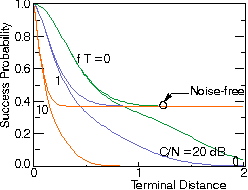
Figure: Probability that an access attempt is successful
versus the distance between terminal and base station.
Uniform Throughput
Terminals in remote areas faces a larger probability to
be unsuccessful during a transmission attempt.
If new packet arrivals are uniformly distributed over the cell,
the number of attempts (successful plus unsuccessful)
increases with range.
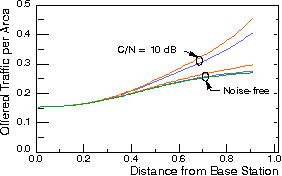
Offered traffic (number of attempts per slot per unit of area) to transmit a packet in an ALOHA
random access network.
This also has an effect on backlog drifts and stability. The delay becomes highly dependent on terminal location. In a network with relatively fixed terminal locations, as in a wireless LAN, some terminals may by accident be positioned in a bad propagation spot, for instance a multipath null. These terminal may have to do many transmission attempts before being successful. Their delay may be unacceptably large, unless special measures are taken (e.g. diversity or frequency hopping).
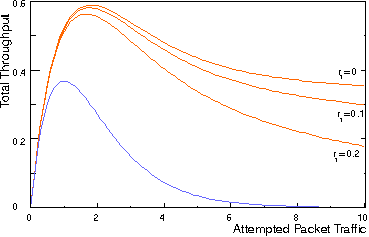
Figure: Total throughput (in message attempts per time slot per unit area)
versus offered traffic in the cell for uniform offered traffic.
For positive r1, the throughput reduces to zero for large offered traffic.
For r1 =0, some packet have extremely strong signals, so they are likely to capture
the receiver despite interference from very many packets.
The throughput goes to
2
lim S = ----------
G->INF p SQRT(z)
with z the receiver capture threshold.
In cellular ALOHA networks, the optimum ALOHA reuse pattern appears to be C = 1.
A network with C = 1 can exploit site diversity: packets received at various base stations can be combined. This is exploited in the Virtual Cellular Network and can also be used in applications such as collection of floating car data The optimum frequency reuse pattern for such a random access network differs from typical solutions for cellular telephone.
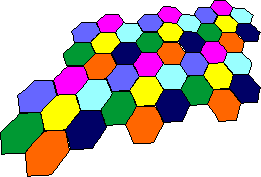
Cellular reuse pattern with seven different frequencies
In the example of a 7-cell reuse pattern, interference between cells is very small, and even at the fringe of each cell the outage probability is not more than a few percent. However,
the use of 7 different channels means that within each cell only 1/7 of the total bandwidth is available.
Hence, the transmission rate is 7 times smaller, as compared to a 1 frequency reuse plan.
Each time slot needs to be seven times larger. For a given arrival rate of ![]() packets per second, the
message arrival rate per slot is thus 7 times larger. If an ALOHA, CSMA, ISMA or similar access scheme is used, this leads to a substantially larger number of collisions
and interference from other packets within each cell. So it appears useful to use a very small cluster size for cellular
ALOHA networks
packets per second, the
message arrival rate per slot is thus 7 times larger. If an ALOHA, CSMA, ISMA or similar access scheme is used, this leads to a substantially larger number of collisions
and interference from other packets within each cell. So it appears useful to use a very small cluster size for cellular
ALOHA networks
The figure below compares various cluster sizes. Uniform offered traffic is assumed in all cells. A modulation technique with 1 bit/s/Hz is assumed that can provide successful packet reception for C/I ratios above 6 or 20 dB.
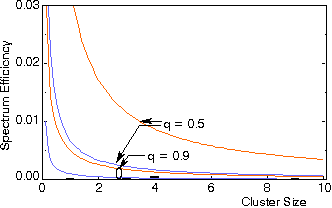
Figure: Throughput of Cellular Slotted ALOHA network (in packets per time slot per base station) for various cluster sizes C. In practice, only the integer values C = 1, 3, 4, 7 , 9 .. exist. Receiver Threshold: orange: z = 4 (6 dB); violet: z = 100 (20 dB)